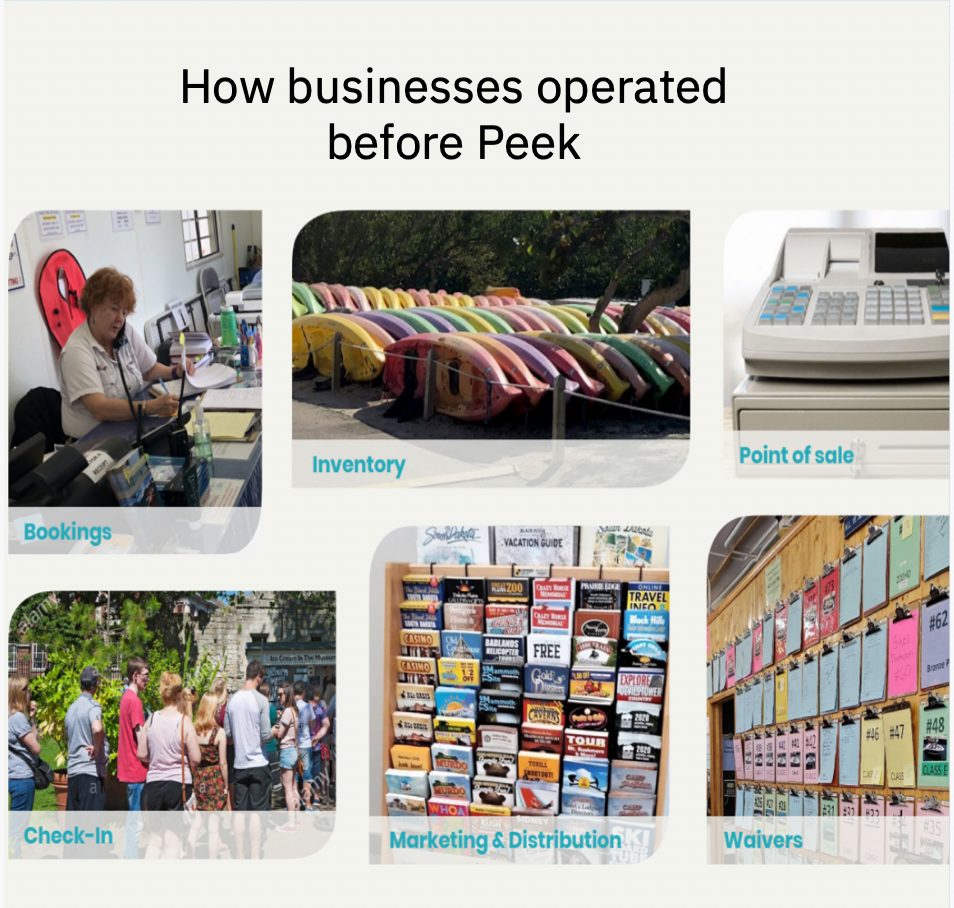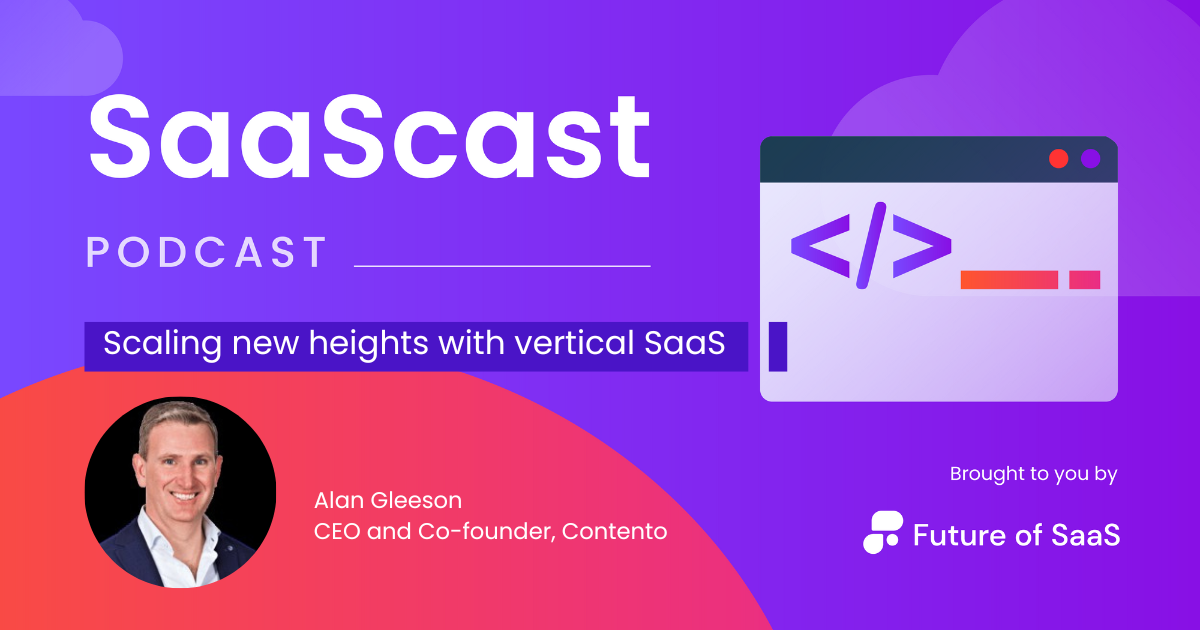This article comes from Navya Rehani Gupta’s talk at the Future of SaaS Festival 2023, check out the full unedited version here.
The world of SaaS is one of the most exciting, competitive, and dynamic industries to work in today, and Navya Rehani Gupta joins us today to share her insights on how to thrive in this ever-changing field.
In particular, she focuses on the enormous potential of vertical SaaS. A fascinating space to work in, Navya adds that ‘vertical SaaS allows us to dive deeper into a specific industry’s problems and challenges, and create bespoke solutions to address them.'
But firstly a little background on our industry expert, Navya Rehani Gupta, Chief Product Officer at Peek. She tells us that at Peek,
‘Our mission is to connect the world through experience. Our industry-leading vertical SaaS solution Peek Pro enables tours & activity operators to supercharge their revenue and streamline operations, powering over $2B+ in bookings.
With almost two decades of experience building large-scale products under her belt, she has navigated her way through various industries, from finance on Wall Street to entertainment at Disney, beauty, and now, travel.
But one thing she’s come to understand is the power of vertical SaaS, especially today, since every industry runs on software, vertical SaaS has never been as essential or valuable as it is right now.
Over the years, Navya has cultivated numerous key strategies that can truly make a difference in achieving success in this space, distilling these learnings here into five critical tips for vertical SaaS success.
These are listening actively to your customers, using this feedback to know where to play and where to stay away, scaling smartly, defining your unique equation with reach and depth, and using data to create a better tomorrow.
So read on to find out more and discover how to optimize your vertical SaaS function today!
- Active listening
- Knowing where to play and where to stay away
- Smart scaling
- Define your unique equation
- Embracing data for a better tomorrow
- Final takeaways and mistakes to avoid
Active listening
Navya highlights that when talking about building successful SaaS products, one of the foundational elements that often gets overlooked is the power of actively listening and prioritizing real customer problems.
It's something that she’s learned makes a substantial difference in product outcomes, and especially in today's highly competitive SaaS environment, customer centricity is a necessity.
Here she adds, ‘it’s not just about hearing what our customers say; it’s about really understanding their needs, their true pain points, and their aspirations.'
Recounting an example of this, Navya explains that she never misses an opportunity to interact with her customers, ‘when I was at Uber, I would regularly speak to drivers about the driver app and ask for feedback.'

Featured here is a picture of her driver, showing Navya how she was carrying a magnifying lens to look at the new map that had been recently introduced and she even had a notebook to track her earnings and check them against what Uber was paying her.
By actively listening to the feedback from her customers, Navya was able to gain unique insights and understand their personal needs, allowing her company to change the app for the better by stepping back and really listening.
She adds, ‘Active listening isn't just about being reactive to customer feedback, but it's about being proactive in seeking it out. It's about being inquisitive, asking the right questions, and constantly looking for ways to better understand your customers' needs.'
Further, ‘it's about creating an open dialogue with your customers, encouraging them to share their thoughts and feedback, and demonstrating that their input is valued and has an impact. And most importantly, it’s about taking action on what you’ve learned to lead to solutions that exceed customer expectations.
In the world of vertical SaaS, which caters to specific industries, active listening becomes even more crucial. Navya highlights that it allows for a deeper understanding of the industry we're serving, comprehending its unique nuances and challenges, and building solutions that truly address them.
So, her first piece of advice to anyone looking to thrive in the vertical SaaS space is: Listen and listen actively. Be open to feedback, be proactive, and be ready to act on it.
Knowing where to play and where to stay away
Moving on to the next aspect, let's talk about strategic positioning. This is about understanding where a product fits into the market and being clear on where to play and, equally importantly, where not to.
When Navya joined Peek, one of the first projects she worked on was defining the company’s market position. Peek is a powerful tool for tour and activity operators, and they knew that their product had the potential to cater to a diverse range of businesses.
However, they also realized that Peek couldn't be everything to everyone. They needed to be strategic about where they focused their efforts and consider how far they would go to solve problems and where they should draw the line.

This positioning exercise continues to be one of Navya’s top priorities in her role, especially since Peek’s customer base, total addressable market and geographical footprint continue to evolve every year.
Having an intentional platform strategy that aligns with your company's vision is crucial. Navya explains this means understanding your strengths and focusing on where you can excel whilst also being able to open up your platform to others in your ecosystem.
So this can include partnerships, integrations, and acquisitions, it is also important to be strategic about which companies to work with, and how to collaborate with them to create new opportunities for growth. The data gathered from this also helps create a robust API framework that enables a company to offer unique solutions.
Once you've defined your market position, the next step is to develop a strong, differentiated value proposition. This is about being competitively aware, understanding what sets your product apart, and why customers should choose you over the competition, without being solely focused on your competitor.
So, be clear about where you want to play and where you don’t. Navya concludes that you need to ‘understand what sets your product apart and ensure that your customers understand it too, this is the key to carving out a successful niche in your chosen vertical.'
Smart scaling
When it comes to vertical SaaS, finding a balance between offering customization and scalability is key. Customization is crucial because vertical SaaS solutions need to speak the language of the customer.
However, it’s equally important to ensure that solutions are scalable, adaptable, and flexible.
For example, when Navya was at StyleSeat, they initially thought of sending reminders to customers to book their next beauty appointment. However, they soon realized that the needs of barbers, nail salons, and hair stylists differed considerably.
What was required was not a one-size-fits-all solution, but a platform that allowed for scalable configurations to cater to the unique needs of each type of business within the beauty vertical.
As a product person, Navya is always guided by the goal of creating value for all stakeholders and considering how her company’s platform will evolve over time. The objective is to holistically solve the problems for customers
Finally, Navya explains that it’s crucial to remember that experimentation is an integral part of platform development. She dives in further, adding that ‘before investing significant resources into building a new feature or functionality, it’s essential to validate the idea and ensure that there's a real need for it.’
This can be done through customer research, surveys, and even through maintaining a space for non-scalable ideas to keep experimenting and innovating.
At Peek, they have a unit called Peek Labs, which allows them to fund non-scalable ideas and understand if these ideas are meeting the milestones for growth. The goal is always to create a platform that meets the unique needs of customers and drives value for all stakeholders.
In essence, smart scaling in vertical SaaS is about balancing customization with scalability and fostering a culture of experimentation.
Navya summarizes this beautifully, ‘be smart about how you scale. Understand the unique needs of your customers and create comprehensive solutions that streamline workflows and add value.’

Defining your unique equation
In today’s exploration of the vertical SaaS world, the fourth tip Navya discusses with us revolves around defining a unique equation with reach and depth. This aspect is crucial as it helps to strike the right balance between serving the needs of current customers and expanding the market base.
If you're doing your job well, your customers' businesses will grow because of you, and their needs will continually evolve.
So, how do you decide whether to focus on retention or market expansion? At the heart of the equation is the ability to please customers. It’s often cheaper to retain existing customers than to go after new ones.

But another way to win in vertical SaaS is by offering multiple products that streamline workflows. Navya emphasizes the key lies in the introduction of multiple products before core business growth starts to slow down or saturate.
For instance, at Peek, Navya points out that they found that their customers appreciate having a suite of products that work seamlessly together. Their financial planning software integrates with their analytics platform, which allows their customers to easily track financial performance and make informed decisions about their business.
Embracing the ecosystem and being honest about the total addressable market, serviceable available market, and how much of that is actually obtainable is vital. You need to understand the market landscape and where your business fits in.
At Peek, when they considered expanding their product offerings, they used customer profit and loss statements to rank potential expansion paths. This method helped them focus on areas where they could materially drive revenue or reduce costs for their customers.
Defining your unique equation is all about understanding the balance between going deep to serve the needs of your current customers and reaching wide to expand your market base. Navya explains that ‘by working to delight your customers, offering holistic product solutions, and understanding your market, you can make informed decisions about where to focus your efforts.’
Embracing data for a better tomorrow
The final tip Navya gives us for vertical SaaS success is the leveraging of data to create a better tomorrow. As the world evolves at a rapid pace, staying ahead of the curve necessitates harnessing the power of data.
However, data remains one of the most underutilized opportunities in vertical SaaS.
Data maturity is a journey that starts with recognizing the importance of data in your business. As you become more proficient in your analysis, you'll start to see how metrics can lead to insights and change behaviors.
Each company's journey is unique, so honesty about data maturity is key to creating a journey of continuous improvement.
Navya neatly concludes, ‘data analysis isn’t about crunching numbers; it's about changing behaviors and making better decisions.’

The unique application of FinTech in vertical SaaS is something truly fascinating. At Peek, they recognize that their partners have their own financial services needs, which is why they embed financial solutions.
But with great data power comes great responsibility.It's crucial to have clear communication around data usage policies. Your customers need to trust that their data is being used safely and securely.
By continually improving your data maturity, offering differentiated solutions, and prioritizing privacy and security, you can stay at the forefront of this data-driven revolution.
Final takeaways and mistakes to avoid
It's an exciting time to be in the vertical SaaS space. By focusing on these five areas Navya highlights, you'll be well on your way to creating a platform that not only meets the unique needs of your customers but also drives value for all your stakeholders.
Her five key takeaways from her journey in vertical SaaS will help shape your own path. From active listening and strategic decision-making to savvy scaling, defining a unique balance between depth and reach, and leveraging data for a better tomorrow, these tips reflect some of the critical lessons she’s learned on her journey.
This journey is complex, with many variables at play. Navya is quick to point out that there’s no one-size-fits-all solution, but hopefully, her insights can provide some guidance and spark new ideas as you navigate your path in the vertical SaaS space.
Enjoyed this article? Why not check exclusive insights from some of the leaeding minds in SaaS with a future of SaaS membership plan?



